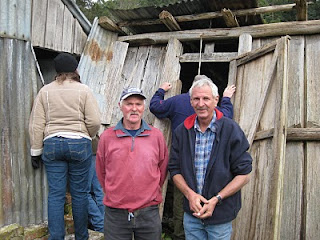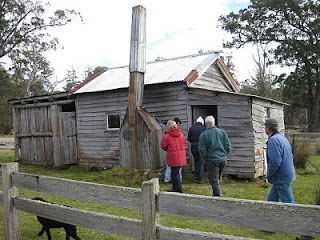
We were keen to get back to Deloraine for this weekend festival, commemorating how the nearby mountains have contributed to the local history.
There’s been a great deal said about the mountain cattlemen of the Snowy River region and Deloraine also has a history of local cattle breeders using mountain pastures for summer feeding. There’s a local Mountain Cattlemen’s Association which has annual gatherings and opportunities for its members to get involved in activities in moving cattle from one place to another, and visiting some of the better-known areas where cattle have been herded for generations.
As has happened in the Snowy Mountains, the cattle families built huts many of which are still being used and others are being restored. There’s also a very active Mountain Huts Restoration Society in this area.
What gives the local huts a special flavour is that they were also used in the winter by members of the families who would trap or snare possums and wallabies for their fur. Prior to the Second World War, a good quality black possum fur might fetch as much as a day’s wages, so trapping and snaring were useful ways of supplementing a family’s income, even during depression times. The design of the Tasmanian huts reflects the multiple uses they had - not only as living quarters but also to meet the need to have a place to peg out the skins for drying.
The object of this Heritage Weekend was to give participants some of the history of the huts and the families associated with them, and get out and visit some of them.
The ABC program, A Big Country, made a documentary in 1980 called The Paddocks. It featured Basil Steers, one of the last of the high country snarers. Basil, in fact, was responsible for building many of the huts around the high plains but he was only one of the people involved in this activity. Many of the descendants of these pioneers took part in the weekend and many of the families retain connection with the huts.
After an interesting and informative session on Saturday, capped off with a lunch of wallaby patties (which was the staple fare of the snarers), we set out on Sunday to visit as many of the huts as we could. There were about 200 people involved on the Saturday and about half that number on Sunday. It was quite a challenge moving a convoy of over 30 4WD vehicles around the narrow mountain tracks and finding places to park near the various sites.
 We’d been told that a herd of Red Herefords was being moved in the area where we would be traveling and, sure enough, we met the beasts with the drovers on horseback. The farmer assured us they were used to traffic but I can’t imagine they would have ever experienced such a convoy as ours.
We’d been told that a herd of Red Herefords was being moved in the area where we would be traveling and, sure enough, we met the beasts with the drovers on horseback. The farmer assured us they were used to traffic but I can’t imagine they would have ever experienced such a convoy as ours.Apart from Basil Steers, who has been made famous by the ABC program, another interesting character is ‘Boy’ Miles, who returned from WW2 after a stint in Changi and on the Burma Railway. His family say he was affected very much by his experiences and found solace in the mountains. One of his nephews told us he was a ‘loner’ and built many huts as retreats.
 The first hut we visited was one of his. You can see the living quarters on the left and the section for pegging out his skins on the right (almost falling down). The section for the skins was built with the framework on the outside and bare slab walls on the inside so that the skins could be nailed directly on to the walls. There were no windows and no chimney and a central fire which was kept burning day and night.
The first hut we visited was one of his. You can see the living quarters on the left and the section for pegging out his skins on the right (almost falling down). The section for the skins was built with the framework on the outside and bare slab walls on the inside so that the skins could be nailed directly on to the walls. There were no windows and no chimney and a central fire which was kept burning day and night.This hut is being removed to the local village of Mole Creek and will be restored as an example of a typical hut of the period.
 The two men in the second picture are Neville (Nipper) and Ray How, nephews of Boy Miles and very knowledgeable about the history of the area.
The two men in the second picture are Neville (Nipper) and Ray How, nephews of Boy Miles and very knowledgeable about the history of the area.Our next stop was the remains of a steam-driven sawmill at Gads Hill.
 This was one of many in the area which flourished before the Second World War. On the outbreak of war, many of the young men employed there left to join up and the sawmill ceased to operate. A hut from the mill was removed to the Borradaile Plains, rebuilt and extended. This hut is now used by a local family who run cattle on the plains in the summer and as a place for their daughters to exercise their horses.
This was one of many in the area which flourished before the Second World War. On the outbreak of war, many of the young men employed there left to join up and the sawmill ceased to operate. A hut from the mill was removed to the Borradaile Plains, rebuilt and extended. This hut is now used by a local family who run cattle on the plains in the summer and as a place for their daughters to exercise their horses.
There wasn’t time for us to visit any other huts today but we’ll certainly make it our business to hunt down more in the future. We intend to join the Mountains Cattlemen’s Association (as non-riding members) and join in some of their activities.
No comments:
Post a Comment